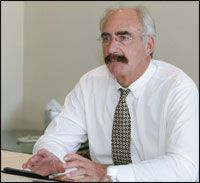Editor's Note: Aligning the Practice Community and Academia
As preceptors, practitioners have the opportunity to model the shape of the profession's future; however, several items are threatening this historical practice—how can we reverse this trend?
Mr. McAllister is a health-systems consultant based in Chapel Hill, North Carolina.

For years, I have heard practitionersfrom virtually all practicesettings complain about schoolsof pharmacy failing to prepare professionalstudents for practice followinggraduation. Although I understand theirconcerns and recognize that some studentsare not prepared to step into theshoes of an experienced pharmacisttheir first day on the job, I also knowthat a recent graduate's drug knowledgeis vastly superior to the curriculum providedto me many years ago. Schools ofpharmacy have a daunting task in termsof meeting the expectations of diverseemployers regarding a new graduate'scapabilities. A host of factors, such asgrowing class sizes, shrinking budgets,dwindling research funding, competitivesalaries for faculty, and faculty retention,contribute to the conundrum.
Changes in academia itself may havean even more profound impact on newgraduate preparedness. The proliferationof distance learning and Web-basedcourse work, which does not requireclass attendance, minimizes the socializationand professionalization that historicallyoccurred during students' collegeexperience.
I understand that new teaching techniquesare necessary to reduce costsand expand enrollment using satellitecampuses to meet market demands, butwhat may be lost in terms of camaraderie,a sense of belonging, lifelong friendships,and professionalization must be maintained.I am confident that our leading collegesof pharmacy understand the risks ofwhat some schools of pharmacy refer toas an "educational renaissance," but I amnot confident that strategiesare in place to shore up whatmay be at risk. Preceptorsmust play an important partin these strategies.
Practitioners in all practicesettings have played anincreasingly important rolein professional education asschools have migrated tothe entry-level doctor ofpharmacy degree curriculum.Regrettably, preceptorsand their employers do notconsistently approach theirclerkship responsibilitieswith an appreciation for theimportance of the role theyserve in preparing future practitioners.We must realize that the time consumedin offering a rich practice experienceis an investment in the profession'sfuture. All too often relationships betweenschools and preceptors (or thepreceptor's employer) are strained withinconsistent alignment of expectations,including getting paid for providing theclerkship itself. Without question, eachschool needs a forum and a consistentprocess for discussing and permanentlyresolving issues.
Aligning practice and academia is acomplex problem, with challenges foracademia, employers, practitioners, andstudents. Not only do we need to overcomehistorical problems, but we urgentlyneed to address the consequencesof dramatic changes in teaching methods.It seems unrealistic to expect thatour professional associations can collectivelylead an initiative with such diversechallenges. Perhaps the AmericanAssociation of Colleges of Pharmacy (withsupport from professional associations)should appoint a commission or otherworking group with representation fromall interested parties, including students,nonpharmacist executives from hospitalsand community pharmacy, academia, anda diverse corps of practitioners to studythe current state of affairs and make appropriaterecommendations. To ensurethat the group remains on target, minutesof meetings and preliminary recommendationsshould be published frequently asthe process evolves so that ample opportunityis given for a successful outcome.
Until then, practitioners from all settingsshould embrace their colleges ofpharmacy and begin at a local level toaddress some of the challenges. I wouldsuggest that practitioners should (1) participatein the process of interviewingapplicants for admission, (2) become apart of early orientation for the students,(3) volunteer to serve as lecturers ordiscussion leaders in class, and (4) leada process to substantially enhance theexperiential portion of the curriculum.
I have confidence that we can use ourcreativity and professional commitmentto resolve this conundrum, as it is in ourcollective best interest. What do youthink?

